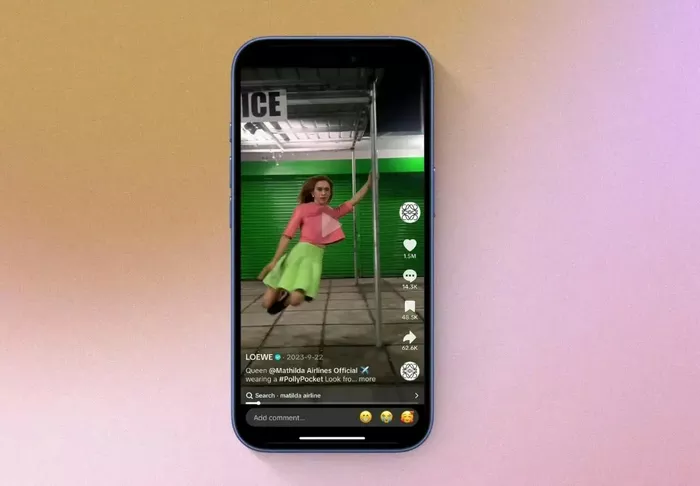When Mathilda Airlines, a TikTok creator from the Philippines, spun into frame wearing Loewe’s Polly Pocket-inspired leather set, the internet couldn’t look away. With 13.8 million views and 1.5 million likes later, it was clear: Loewe knows exactly how to work the TikTok algorithm. By showcasing a rising influencer with a viral signature move, the Spanish luxury brand turned a simple pole spin into high-fashion currency.
In today’s digital age, Loewe and Jacquemus have become the epitome of fashion’s “extremely online” presence. They’re not just brands with TikTok accounts—they’re fluent in the platform’s unique language. While traditional luxury marketing often hinges on exclusivity, both brands have embraced a more playful, spontaneous approach that thrives on relatability, without sacrificing their high-end image.
For Loewe, humor plays a vital role in connecting with its online audience. Take, for example, a simple TikTok post that begins with a casual “Hey girls, is it cold out?” moment, featuring a shaggy yellow coat. The video quickly amassed millions of views, demonstrating the brand’s savvy use of meme culture and trending sounds. Loewe shies away from high-production content, instead opting for fun, behind-the-scenes glimpses and humorous celebrity cameos, all while subtly integrating their products. These posts exude an unscripted, genuine energy that resonates with viewers.
Jacquemus, on the other hand, employs a different strategy but achieves similar results. Its TikTok presence has a dreamy, surreal quality, evoking a mood board in motion. The brand’s videos are a blend of ASMR, fashion fantasy, and Provençal color palettes, offering a whimsical yet grounded feel. Just when you think you’ve got Jacquemus figured out, they throw in an unexpected twist—a dancing security guard from Davao, for example.
Ryniel Pineda, a Filipino TikTok star known for his upbeat dance routines, recently appeared on Jacquemus’s official page, dancing alongside a “La Croisière” show poster and a casually placed Turismo bag. The caption read, “Paris, this diva has arrived early.” The video went viral, accumulating 12 million views and showcasing Jacquemus’s willingness to blend runway fashion with real-life, everyday moments.
Despite their viral success, not everyone is convinced by the strategy.
One critic commented, “I enjoy [Loewe’s] behind-the-scenes content but find their meme and joke posts juvenile and inconsistent with the brand’s image. I hate how so much of social media is geared toward teens.” This sentiment reflects a broader concern about the shift toward viral entertainment, with some questioning whether this approach dilutes brand integrity.
Another user was even more blunt, stating, “So many brands chase quick trends for surface-level engagement, but what happens when the likes don’t translate to loyalty? Long-term brand value isn’t built on virality.” They went on to argue, “Founders dancing and miming on TikTok might win views, but does it actually build brand equity? There’s a difference between visibility and value.”
However, both Loewe and Jacquemus continue to thrive because they understand TikTok’s core essence: it’s not about direct conversion, but about building connections. Authenticity on this platform isn’t about achieving polished perfection but embracing the chaos and spontaneity that comes with it. Instead of dictating trends, these brands meet their audience where they are, proving that the future of fashion marketing is bold, irreverent, and full of unexpected moments.
Related Topics
- Fashion Labels Expand Into Film Industry with Growing Partnerships at Cannes Festival
- 10 Affordable British Fashion Brands That Deliver Luxury Without the Price Tag
- Luciano Benetton at 90: Celebrating a Life Marked by Fashion, Business Triumphs, and Controversies

